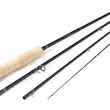While scanning the internet recently, I happened across an article titled “Why Fish Double-Taper Fly Lines?” A website reader wondered what these lines were for, noting that he didn’t know anyone that fished one. The article’s author then opined that he himself had never fished a double-taper either. Seeking an answer, the question was passed on to some other folks.
To my mind, however, Why fish a double-taper? isn’t the telling question. Rather, what we should be asking is, Why fish a weight-forward? Indeed, considering the relative merits of each taper, it’s long struck me as odd that the weight-forward has so convincingly supplanted the double-taper as the de facto line choice for today’s anglers (I’m referring here to floating lines).
After all, double-tapers were the standard in this sport for ages. Weight-forwards are a comparative newcomer, specialty lines that arose from the quest for distance. But somewhere in the neighborhood of thirty years ago this paradigm changed, and weight-forwards took over the world. They shouldn’t have.
From a practical point of view, the only advantage a weight-forward line has over a double-taper line is the ability to cast long distances—say, over 75 feet. But even this advantage carries a caveat. To wit, you must use a line-size heavy enough so that a double-haul can exploit the difference in weight between the line’s head and running line (the heavier head essentially drags along the lightweight running line, adding distance to the cast). This means using a 6-weight line or heavier. Anything lighter and there simply isn’t enough weight difference between the head and the running line to gain significant extra distance, double haul or not. (One can argue here for 5-weights, but it’s a borderline argument.) Weight-forward 2, 3, and 4s … hmm … why are they even made?)
While heavier weight-forward lines do have distance advantages over double-tapers, the fact that this extra distance comes from shooting the running line can be somewhat limiting. Actually, in certain kinds of fishing it can be a real problem. For instance, when gulper fishing (dry fly fishing to cruising trout in lakes) long casts are often integral to success. That’s because they increase the number of chances possible at a given fish, either before the fish swims out of range or before it spooks by coming too close. But in this kind of fishing I don’t want to rely on shooting line for my distance. Inaccuracy results from that. And if I do make a bad cast or a fish passes up my fly, I don’t want to have to strip in a bunch of line (to get to the head) before I pick up and make another cast. Too much wasted time. Instead, I want to pick up my line immediately, make one backcast, and lay it right back out. Double-tapers allow me to do that.
Another problem with weight-forwards is that they don’t mend well at distances longer than the length of the head (the thin running line cannot effectively manipulate the heavier head). Although this is typically of more consequence to steelhead and salmon fishermen, it still plays a role in many types of trout fishing. In contrast, double-tapers mend exceptionally well.
Weight-forward lines almost universally have very short tips and front tapers, which promote an abrupt, harsh turnover of leader and fly. Double tapers, with their longer tips and tapers, offer a much smoother turnover—a wonderful quality that adds to the pleasures of casting and aids presentation in delicate fishing situations.
Double-taper lines also permit you to reverse your line when one end wears out. So you get two lines in one. In this day and age, with some fly lines costing over $100.00, that’s a nice benefit. It’s especially nice when you realize that you don’t give up any performance to get it.
It’s been noted as a disadvantage of double-tapers that they take up more room on a reel. Which means you’ll have less backing on your reel. True. But having less backing isn’t the same as having no backing, and any adequately sized reel provides for a reasonable allowance. (I think most of us know how infrequently we need it for trout fishing.)
There are other considerations between the two tapers, but here’s the bottom line. I can think of just one fishing situation—fresh or saltwater—where I would opt for a weight-forward line instead of a double-taper (and it’s a long belly weight-forward, which doesn’t really count, since the benefits of such a line are more akin to those of a double-taper anyway). Nevertheless, here it is: long cast required—at least 75 feet. A need for a heavy line—7-weight or heavier. Single casts only at sighted fish or multiple casts if fishing blind—the point being that in either case the amount of time between casts isn’t important (so there’s no penalty for the extra time it takes to strip in the line before making another cast). Finally, no line manipulation necessary after completing the cast.
Is there real world fishing that fits these criteria? Sure there is, but for most of us it’s probably out of the ordinary. Think, perhaps, of certain tarpon or permit fishing. Or casting to a feeding frenzy of stripers or bluefish. Maybe stripping streamers for trout in a big river or reservoir. If you engage in any of these pursuits, then by all means use a weight-forward line. But if you find yourself in more conventional situations, especially fishing for trout, consider the double-taper.
There are good reasons these lines were made in the first place—reasons that I daresay still prevail.






























Comments
Anonymous replied on Permalink
Bingo on all points. Well presented as a double taper does the best. You don't need a hero cast, just as damn good cast and presentation.
Bob White replied on Permalink
In his usual fashion, John Juracek provides valuable information and logic in this article. Thanks!
Patrick McCabe replied on Permalink
I am totally in agreement here. DT lines are simply a better tool for almost all fishing situations. Better control of fly line both in the air and on the water. I do wish fly shops would keep a better stock, especially from 3-5 wts.
Brian Ramsey replied on Permalink
This is a funny article. It's about marketing. The current state of weight forward line development is geared towards new comers into the sport(and stiff rod actions that don't bend) and fly shop casting in paved parking lots and selling gear.
A correct weight forward should have at least 9' of front taper and a long belly of at least 43' and tapering down into running line for a nice smooth casting/wind resistant/gravity defying perfect, light lay down presentation. Double-taper front tapers should be the same, but instead of running line it just goes into same 9' length of front taper. The front taper is key in all this! I think most modern lines in both tapers have only 3-4' on average which makes for a fast turnover and conversely shorter distance casting, less control, less overhang results in shorter less controlled casting. Paul Arden of Sexy Loops jokingly pointed this out a few years ago on his website asking Bruce Richards why the crappy modern fly line tapers of today are common place saying that $90 modern fly lines are kinda of a joke from a technical fishing/casting standpoint and are meant to hook beginning anglers, because they can shoot 50' of fly line from the get go and not much further(cha-ching, product sold!). But if beginning anglers wanna get better distances not knowing about longer tapers and simply better casting techniques are the key, not short choppy fly line tapers, then learning the sport is gonna be a super long learning curve and a large participation drop out rate in the end.
Anyways, great read and topic. I use only double tapers for all my trout fishing floating lines just too much versatility to give it up (try a roll cast once in awhile folks or aerial mending); people shud check out John's website and watch the various(but similar) styles of casting by the likes of Dave Shultz...sure wish we had some clips of Paul Brown casting a double-taper with one his earlier '80s Fenwick designed soft rods or even stiff rods and how easy and smooth it looks and something fun to aspire to. Good Casting and focused fishing blended together should be relaxing, fun and above all...smoooothh.
*The line taper charts on the 406 Fly Line website are the right tapers of fly fishing of a bygone era....and smooth; are an example of what I'm talking about as far as tapers should be like. This was common place 25-30yrs ago for both tapers and all brands. This formula is the perfect standard and if different (like modern fly lines are) kinda like reinventing the wheel. Don't mess with it. The old Sunset line tapers were the gold standard that we'll never see again! 'Magine combining modern materials tech blending with those tapers!
Josh friedman replied on Permalink
I don’t know enough personally to comment, but I have heard tom rosenbauer say, on more than one occasion, that, for most, not all, trout fishing, there’s no real difference between WF and DT because for the first 35-40 feet, the tapers are largely the same. Maybe that reflects a small stream fishing perspective? Thoughts?
John Juracek replied on Permalink
In theory, and back in the day, Tom is right—the front 30’ of DTs and WFs weighed the same and often had the same taper. Not so today. WFs now are frequently heavier than the standard, and most of the front tapers are shorter and steeper than DTs.
Josh friedman replied on Permalink
Thanks!
Brent James Schlenker replied on Permalink
I use both Double Taper and Weight Forward lines. The Double Taper on a mid flex rod is a great little single hand spey rod. Very efficient on covering lots of moving water quickly and quietly. Many anglers are missing some great opportunities with this fly line. Also works well for casting indicators on lakes.
Another very useful tool for you to enjoy.
Jon B. Tobey replied on Permalink
I went to buy a line the other day and I had to search for a DT. For the reasons you mention, this made no sense. As far as WF lines go, thank you for mentioning the Emperor wears no clothes. But it does show that marketing triumphs common sense.
Nick Anaclerio replied on Permalink
AMEN.
Anonymous replied on Permalink
I fish both WF and DT, but find the DT more versatile, as eluded to here. One place the DT is a clear winner is on long roll casts, which I find myself using almost by default when using a double taper. Great in restricted backcast areas, which I find myself in very often in western Colorado.
DanD replied on Permalink
Another great article by John. Thanks.
Oliver von Richter replied on Permalink
Thank you for this interesting article and viewpoint. I have gone through a testing phase of all kinds of fly lines in the past three years. This was because it is neither the fly rod nor the fly line that is more important to effective casting and more importantly fishing style but the pairing of the fly rod with the respective fly mine for a specific purpose and adjusted to the personal preference and skill of each individual angler.
In my view many WF taper are an evolution of the classic DT taper. Many long belly WF tapers are very close to the original DT design. It’s hard to dinstinguish an SA Trout from a DT taper. It essentially does the job on modern faster rods. If the rod is a bit faster use a slightly heavier Rio Technical Trout. If you’re using indicator nymph rigs that requires a little more mending use a Rio Single Handed Spey with most of the weight concentrated at 30 ft. All these lines have been generated not essentially as marketing gags but to offer more specialsation for a preferred type of fly fishing.
If you’re a beginner with no time to read a master thesis and have a medium fast rod and you’re looking for a universal fly line - buy a double taper (if you can find one). You will soon realize that effective fishing requires much more line handling which is easier than a DT and you only will have to cast 45 ft anyway in most waters.
DT are here to stay, just watch the masters of fly casting teaching the Italian style (SIM Suisse). They are using DT lines.
Richard Frank replied on Permalink
John,
I fished bamboo for many years and at that time used DT lines almost exclusively. The exception was the Triangle Taper with its long continuous taper. Lines through WT4 have a 36’ head and heavier lines have a 40’ head. That means, in effect, that with leader and tippet you’re in good shape out to 50’+. Beyond that you get running line for longer casts when needed. I’m curious about why this design hasn’t been more popular? The newer TT lines have an improved, slicker coating and they’ve remained very affordable. I have no stake in their sale. I just think they are worthy of more consideration than they tend to get.
Jack Donachy replied on Permalink
OK. You got me thinking... Thanks! JD
Pages